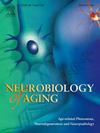长期基底核胆碱能损伤可改变Wistar大鼠皮质血管结构、星形胶质细胞密度和小胶质细胞活性
IF 3.5
3区 医学
Q2 GERIATRICS & GERONTOLOGY
引用次数: 0
摘要
基底前脑胆碱能神经元(BFCNs)是人类大脑皮层和海马胆碱能神经支配的唯一来源,也是啮齿动物胆碱能神经支配的主要来源。该系统在老年痴呆症中经历了早期退化。BFCNs末端突触通过与其他神经元的经典突触接触参与脑血流量的调节。此外,它们位于大脑皮层血管附近,与神经血管单元(NVU)的各种细胞类型形成连接,包括血管平滑肌细胞、内皮细胞和星形细胞终足。然而,BFCNs输入对NVU组分的影响仍未得到解决。为了解决这个问题,我们对2.5月龄Wistar大鼠进行了双侧立体定向注射胆碱能免疫毒素192- igg -皂苷免疫。病变后7个月,我们观察到皮质囊泡乙酰胆碱转运免疫反应突触显著减少。这伴随着皮质毛细血管和毛细血管前小动脉直径的变化,以及血管内皮生长因子A (VEGF-A)水平的降低。此外,胆碱能免疫刺激增加了皮质星形胶质细胞和皮质小胶质细胞的密度。在bfcn病变后的阶段,星形细胞终足与小动脉的共定位增加。顶叶皮层的小胶质细胞数量与胆碱能损失相关,并表现出表明中间激活状态的形态变化。促炎介质IFN-γ、IL-1β和KC/GRO (CXCL1)水平的降低以及M2标记物SOCS3、IL4Rα、YM1、ARG1和Fizz1的表达增加支持了这一点。我们的研究结果提供了一个新的见解:基底核胆碱能输入的丧失对皮质血管、NVU成分和小胶质细胞表型产生负面影响。本文章由计算机程序翻译,如有差异,请以英文原文为准。
Long-term nucleus basalis cholinergic lesions alter the structure of cortical vasculature, astrocytic density and microglial activity in Wistar rats
Basal forebrain cholinergic neurons (BFCNs) are the sole source of cholinergic innervation to the cerebral cortex and hippocampus in humans and the primary source in rodents. This system undergoes early degeneration in Alzheimer's disease. BFCNs terminal synapses are involved in the regulation of the cerebral blood flow by making classical synaptic contacts with other neurons. Additionally, they are located in proximity to cortical cerebral blood vessels, forming connections with various cell types of the neurovascular unit (NVU), including vascular smooth muscle cells, endothelial cells, and astrocytic end-feet. However, the effects of the BFCNs input on NVU components remain unresolved. To address this issue, we immunolesioned the nucleus basalis by administering bilateral stereotaxic injections of the cholinergic immunotoxin 192-IgG-Saporin in 2.5-month-old Wistar rats. Seven months post-lesion, we observed a significant reduction in cortical vesicular acetylcholine transporter-immunoreactive synapses. This was accompanied by changes in the diameter of cortical capillaries and precapillary arterioles, as well as lower levels of vascular endothelial growth factor A (VEGF-A). Additionally, the cholinergic immunolesion increased the density of cortical astrocytes and microglia in the cortex. At these post-BFCN-lesion stages, astrocytic end-feet exhibited an increased co-localization with arterioles. The number of microglia in the parietal cortex correlated with cholinergic loss and exhibited morphological changes indicative of an intermediate activation state. This was supported by decreased levels of proinflammatory mediators IFN-γ, IL-1β, and KC/GRO (CXCL1), and by increased expression of M2 markers SOCS3, IL4Rα, YM1, ARG1, and Fizz1. Our findings offer a novel insight: that the loss of nucleus basalis cholinergic input negatively impacts cortical blood vessels, NVU components, and microglia phenotype.
求助全文
通过发布文献求助,成功后即可免费获取论文全文。
去求助
来源期刊

Neurobiology of Aging
医学-老年医学
CiteScore
8.40
自引率
2.40%
发文量
225
审稿时长
67 days
期刊介绍:
Neurobiology of Aging publishes the results of studies in behavior, biochemistry, cell biology, endocrinology, molecular biology, morphology, neurology, neuropathology, pharmacology, physiology and protein chemistry in which the primary emphasis involves mechanisms of nervous system changes with age or diseases associated with age. Reviews and primary research articles are included, occasionally accompanied by open peer commentary. Letters to the Editor and brief communications are also acceptable. Brief reports of highly time-sensitive material are usually treated as rapid communications in which case editorial review is completed within six weeks and publication scheduled for the next available issue.
 求助内容:
求助内容: 应助结果提醒方式:
应助结果提醒方式:


